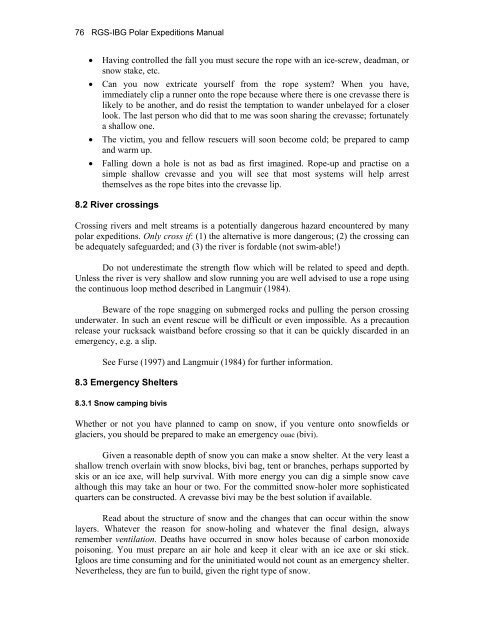Edited by Rachel Duncan 4th Edition ISBN 0-907649-91-2 London ...
Edited by Rachel Duncan 4th Edition ISBN 0-907649-91-2 London ...
Edited by Rachel Duncan 4th Edition ISBN 0-907649-91-2 London ...
You also want an ePaper? Increase the reach of your titles
YUMPU automatically turns print PDFs into web optimized ePapers that Google loves.
76 RGS-IBG Polar Expeditions Manual<br />
• Having controlled the fall you must secure the rope with an ice-screw, deadman, or<br />
snow stake, etc.<br />
• Can you now extricate yourself from the rope system? When you have,<br />
immediately clip a runner onto the rope because where there is one crevasse there is<br />
likely to be another, and do resist the temptation to wander unbelayed for a closer<br />
look. The last person who did that to me was soon sharing the crevasse; fortunately<br />
a shallow one.<br />
• The victim, you and fellow rescuers will soon become cold; be prepared to camp<br />
and warm up.<br />
• Falling down a hole is not as bad as first imagined. Rope-up and practise on a<br />
simple shallow crevasse and you will see that most systems will help arrest<br />
themselves as the rope bites into the crevasse lip.<br />
8.2 River crossings<br />
Crossing rivers and melt streams is a potentially dangerous hazard encountered <strong>by</strong> many<br />
polar expeditions. Only cross if: (1) the alternative is more dangerous; (2) the crossing can<br />
be adequately safeguarded; and (3) the river is fordable (not swim-able!)<br />
Do not underestimate the strength flow which will be related to speed and depth.<br />
Unless the river is very shallow and slow running you are well advised to use a rope using<br />
the continuous loop method described in Langmuir (1984).<br />
Beware of the rope snagging on submerged rocks and pulling the person crossing<br />
underwater. In such an event rescue will be difficult or even impossible. As a precaution<br />
release your rucksack waistband before crossing so that it can be quickly discarded in an<br />
emergency, e.g. a slip.<br />
See Furse (1997) and Langmuir (1984) for further information.<br />
8.3 Emergency Shelters<br />
8.3.1 Snow camping bivis<br />
Whether or not you have planned to camp on snow, if you venture onto snowfields or<br />
glaciers, you should be prepared to make an emergency ouac (bivi).<br />
Given a reasonable depth of snow you can make a snow shelter. At the very least a<br />
shallow trench overlain with snow blocks, bivi bag, tent or branches, perhaps supported <strong>by</strong><br />
skis or an ice axe, will help survival. With more energy you can dig a simple snow cave<br />
although this may take an hour or two. For the committed snow-holer more sophisticated<br />
quarters can be constructed. A crevasse bivi may be the best solution if available.<br />
Read about the structure of snow and the changes that can occur within the snow<br />
layers. Whatever the reason for snow-holing and whatever the final design, always<br />
remember ventilation. Deaths have occurred in snow holes because of carbon monoxide<br />
poisoning. You must prepare an air hole and keep it clear with an ice axe or ski stick.<br />
Igloos are time consuming and for the uninitiated would not count as an emergency shelter.<br />
Nevertheless, they are fun to build, given the right type of snow.

















